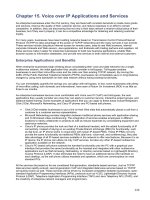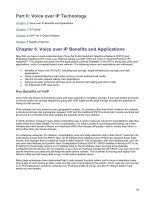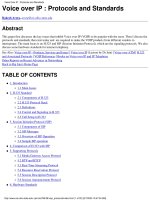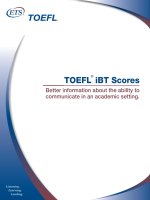Tài liệu Voice over IP Open-Source Platforms and the Session Initiation Protocol pptx
Bạn đang xem bản rút gọn của tài liệu. Xem và tải ngay bản đầy đủ của tài liệu tại đây (154.77 KB, 11 trang )
Voice over IP
Open-Source Platforms
and the Session
Initiation Protocol
1-800-COURSES
www.globalknowledge.com
Expert Reference Series of White Papers
Introduction
Voice over IP (VoIP) communications can be separated into two categories: business and residential. The
early growth of VoIP was primarily in the residential space, fueled mostly by PC enthusiasts. Businesses
need practical and reliable phone service, early VoIP technology proved unreliable. At first, the business
community didn’t pay much attention to VoIP because the early versions of the technology had very poor
quality much of the time. However, over the last 10 years, the world of voice communications has made
dramatic changes
.
Businesses usually purchase their phone systems from a particular voice equipment manufacturer or reseller. In
many cases they also rely on the same source for the installation and maintenance of these systems. They usu-
ally decide on a particular product based on system features that map well to their business needs.
Today, voice equipment vendors scramble to get their latest VoIP products and/or upgrades to market. In some
instances, vendors have lost major market share due to poor products or by being a late entrant into the VoIP
market.
Some vendors with an early lead have lost out to traditional phone equipment manufacturers that
have developed superior VoIP system designs and strateies.
While competition is intense among equipment vendors, the emergence of open source VoIP software plat-
forms adds a new threat to the voice equipment suppliers that serve small-to-medium size businesses (SMBs).
If this trend continues, it is only be a matter of time before the steady improvement of these software plat-
forms will threaten the equipment vendor’s market share of large businesses.
The Impact of Voice over IP (VoIP) in Telecom
VoIP: the Early Years
T
he Internet has made global communications very inexpensive
.
First, the introduction of multimedia PCs and
PC-based softw
are provided the platform for virtual phones, known as softphones. These softphones were the
beginning of a revolution in voice communications known as VoIP.
This early version was basically PC-to-PC communications using a headset or a microphone and speakers.
Connectivity could only be achieved between two parties if the caller knew the recipient’s IP address. To estab-
lish a voice call,
both parties needed a PC connected to the internet, and the softphone application had to be
launched. In addition, early multimedia systems could only provide half-duplex communications or a walkie-
talkie type experience.
Donald Hill, Global Knowledge Course Developer and Instructor
Voice over IP Open-Source Platforms
and the Session Initiation Protocol
Copyright ©2006 Global Knowledge T
raining LLC. All rights reserved.
Page 2
D
uring this early period, most residential access to the Internet was dial-up connectivity, which offered very
limited capacity. Data packets traversing the Internet were usually delayed, due to limited dial-up capacity and
network. Voice calls over the Internet weren’t a very practical means of voice communications.
Standardizing VoIP
Three major protocols have shaped the VoIP landscape of today. The first two are signaling protocols devel-
oped to establish communication between two or more parties. The third protocol focuses on the actual trans-
port of the media (e.g., voice or video). The first signaling protocol was developed through the International
Telecommunications Union (ITU-T). The second protocol for signaling and a third protocol for media transport
were developed through Internet Engineering Task Force (IETF).
In 1996, the ITU-T began to develop international recommendations for multimedia communications over
packet-based networks. The goal was to facilitate the convergence of voice, video, and data communications.
The core recommendation, or standard, was called H.323; version 5 of this protocol suite is the latest update.
More information detailing various audiovisual and multimedia systems can be obtained at
/>IETF developed the first version of the Session Initiation Protocol (SIP), which was released in 1999. It was
developed to initiate
, modify, and terminate an interactive user session that involves multimedia elements
(e.g., video, voice, instant messaging, etc.).
The Multiparty Multimedia Session Control (MMUSIC) working group (f
.org/html.charters/mmu-
sic-charter.html) continues to guide the development of SIP.
In 1996, the IETF published Request for Comment (RFC) 1889, which defined a standardized packet format used
for packaging and delivering real-time communications, such as audio and video, over the Internet. The original
document has since been superceded by RFC 3550, RTP:
A Transport Protocol for Real-Time applications.
The VoIP Equipment Vendor Landscape
The H.323 recommendation w
as the first real-time communications standard available to the mark
et.
As a
result, H.323 has been the springboard for the development of many proprietary systems by traditional tele-
phone equipment vendors
,
as well as their data network equipment vendors
. As a result of these standardiza-
tion efforts, commercial VoIP has had a significant impact on the type of products being developed and from
whom they are being purchased.
In 1998, networking equipment giant Cisco Systems got off to an early lead in the VoIP market after acquiring
the CallManager product through the acquisition of Selsius Systems. This allowed Cisco Systems to introduce a
packet-based voice system that competed with other traditional vendors, such as Alcatel, Avaya, Mitel, Nortel,
and Siemens. Since then, these and many other vendors have developed their own proprietary VoIP systems in
response to the growing demand for
V
oIP systems
.
Traditional phone systems for enterprise (private) networks are known as Private Branch Exchanges (PBXs),
and VoIP-based PBXs are referred to as IP-PBXs. These systems are not limited to products based on H.323;
they are now spread across a wider standards base for signaling (call control).
Copyright ©2006 Global Knowledge T
raining LLC. All rights reserved.
Page 3
Session Initiation Protocol (SIP)
SIP Gains Support from the Cellular (Mobile Wireless) Community
SIP’s popularity has grown enormously over the past few years. A big boost in support came in November
2000, with the acceptance of SIP by the 3rd Generation Partnership Project (3GPP). 3GPP is composed of stan-
dards organizations in China, Europe, Japan, North America and South Korea, and is dedicated to the prolifera-
tion of a third-generation wireless global standard. More specifically, this organization focuses on the develop-
ment of standards for the Universal Mobile Telecommunications System (UMTS). Furthermore, the 3GPP devel-
oped the IMS (IP Multimedia Subsystem), which defines the way VoIP services will be implemented over
General Packet Radio Services (GPRS) and UMTS cellular networks.
Another cellular standards organization, the 3rd Generation Partnership Project 2 (3GPP2), is dedicated to pro-
moting their version of the next-generation mobile wireless standard, called cdma2000. The 3GPP2 is in the
process of adopting the 3GPP IMS framework, which means they also see the significance of SIP. They refer to
their IMS innovation as Multi-Media Domain (MMD), sometimes called “All IP Core.”
SIP Affects Service Providers and the Public Network
SIP has become an acceptable way for signaling voice communication connections and related services. It is now
used as a gateway service between the Internet and the Public Switched Telephone Network (PSTN). Currently,
the most popular service provider in the U
.S. is Vonage. Advertisements for these providers state that all a
prospective customer needs is broadband access to the Internet. The analog telephone adapter (ATA) devices
used to connect a standard phone to the Internet via the broadband connection are sold in many retail outlets.
The operation is dependent on a protocol that can connect these ATAs, to SIP proxy servers, which provide
both inbound and outbound service to a registered device, allowing Vonage customers to call other Vonage
customers. However, the other critical piece to their service is the Internet-to-PSTN gateways, where PSTN traf-
fic converts to VoIP packets and vice versa, strategically placed throughout the world to provide international
voice service
. These gateways allow Vonage customers to make and receive calls over the public switched net-
work as well.
Vonage is not the only company providing phone service over the Internet. However, SIP is one common
thread among most of the Internet Telephony Service Providers (ITSPs) that are providing this type of service.
The Evolution of SIP in Enterprise VoIP Networks
In addition to the mobile wireless industries, support for SIP is found in many IP-PBXs originally developed
using a proprietary version of H.323. This strong demand by customers has translated into a more open stan-
dard supported by many vendors. The move towards SIP opens up these platforms for third-party SIP phone
support,
which is a very significant change
.
In the past, an enterprise purchased their phone system from one vendor. The entire system was proprietary,
and the phones and the system came from the same vendor. If you liked the features of another vendor’s
phone sets, you had to purchase their system to support those features. There were very few instances of
cross-vendor phone support, and certainly no relationships between major competitors. SIP is undoing this pro-
prietary vendor hardw
are lock.
Copyright ©2006 Global Knowledge T
raining LLC. All rights reserved.
Page 4
SIP Is Ubiquitous
• With the adoption of SIP, the new version of Cisco’s CallManager (v.5) supports SIP-based third-party
phones. The core platform is supporting SIP along with their proprietary protocol, Skinny Client Control
Protocol (SCCP).
• Avaya’s MultiVantage VoIP system uses the SIP Enablement Services (SES) to create a communication
services layer within the architecture that supports SIP.
• In June 2005, Nortel and Polycom announced a partnership to support video conferencing based on the
SIP protocol between their equipment. Interestingly, the solution also supports H.323.
• Now we are seeing the emergence of a SIP-based product from the ground up, versus dual support of a
proprietary protocol and SIP as an added option. Pingtel’s SIPxchange PBX is an example of this.
Another good example is Zultys MX1200, a SIP-based platform.
These are all good examples of the impact SIP is making on the voice industry, whether they are wired or wire-
less systems. Since SIP has become an ubiquitous open signaling standard, the other necessary ingredient for
inexpensive communications is opening the voice platform itself.
Open-Source Operating Systems
The Affect of Linux on the Operating System Market
A group of employees at AT&T’s Bell Labs developed the UNIX operating system for the Digital Equipment
Corporation PDP-7 mini computer during the late 1960s and early 1970s. This spawned other popular versions
of UNIX, including the Berkeley Software Distribution (BSD). Various other versions of UNIX, such as Sun and
Hewlett-Packard, continued to evolve at universities and corporations.
These v
arious iterations of UNIX spurred a development project by the Free Software Foundation (FSF). Their
goal w
as to create a free operating system that w
as UNIX-lik
e but didn’t contain any actual UNIX code.
The success of Linux has been phenomenal. At first, the operating system interface was command line-based.
However, back in 1984, MIT originated the x project, which later evolved into the X Window System, providing
the framework for a Graphical User Interface (GUI).
Once this development w
as integrated with the Linux distri-
bution, desktop environments like GNOME and KDE gave Linux a look and feel similar to Microsoft Windows and
the Mac environments. This has allowed a wider acceptance of Linux in the desktop operating system arena.
More importantly
, Linux has been widely accepted in the server environment. Apache is a free software/open
source HTTP Web server that runs on UNIX, BSD and Linux operating systems. Various surveys repeatedly show
that Apache runs on over 60 percent of the world’s Web servers. This powerful open source free software oper-
ating system/Web server combination has been the cornerstone for many application development projects.
Note:
Some versions of Linux must be purchased. These versions normally provide support, solid documenta-
tion, and additional tools developed by the software distributor. Red Hat is one of the best examples of a com-
pany that packages Linux for sale, along with many other solutions and services.
Copyright ©2006 Global Knowledge T
raining LLC. All rights reserved.
Page 5
Comparison of Open-Source Software to Proprietary Software
Advantages of Open Source
• There is no license fee. Proprietary software requires either a per-seat or site license.
• Open source allows users to change the source code at will. Proprietary source code is tightly controlled,
with limited or no alteration allowed.
• Open source engages a community of developers. Proprietary software depends solely on the vendor’s
development staff for revisions and bug fixes.
Advantages of Proprietary Software
• With proprietary software, there is dedicated support. Usually, with open source software, there is no
dedicated support. However, IBM and Hewlett-Packard, along with other organizations support open
source software platforms for fees.
• Proprietary software has professionally written documentation. Open source software is provided by the
community, which usually means not well written documentation; in some cases documentation is non-
existent. In many cases there are books on the subject available at a reasonable cost.
However, many of
these books don’t necessarily reflect the latest revision released by the software community.
• Software releases for proprietary software are driven by vendor revenue targets and customer feedback.
Software releases for open source are driven by the community as time permits the individual develop-
ers to create new features or fix bugs within the existing software.
Open-Source Software Products for VoIP
Many of the VoIP softw
are developments listed here run strictly on Linux,since open source projects tend to
gravitate towards open source operating systems. However, there is support for UNIX variants and Microsoft
Windows operating systems. In a few cases, some software has been written for both operating system envi-
ronments. There are several new developments and operating system platforms, you simply have to check
before downloading a package you may wish to try.
H.323-Based Open Source
Open source software packages that support VoIP can be divided into two categories: H.323 and SIP. A good
example of open source development based on H.323 is the GNU Gatekeeper, OpenH323, which has the func-
tionality of an IP-PBX. It is very powerful, but doesn’t contain many of the bells and whistles found in propri-
etary systems. In addition, there are several others, including softphones, software VoIP-to-PSTN gateways, etc.
SIP-Based Open Sour
ce
There are several SIP development packages making it difficult to list them all. A few of the more visible proj-
ects are covered below
.
T
here are a few
W
eb sites that post these SIP softw
are packages for downloading,
and
they are good resources to find out more about each of these projects.
Pingtel and SipX
SipX is a IP-PBX solution that was originally based on SIP that runs on Linux. The three versions of open
source, Linux-supported software are: CentOS (v. 4.2), Fedora Core (version 3 and 4), and Debian Sarge.
Copyright ©2006 Global Knowledge T
raining LLC. All rights reserved.
Page 6
S
ipX (Release 3.0) can be found on the SIPfoundry Web site, www.sipfoundry.org. According to that site (under
Open Source VoIP Solutions):
“SIPfoundry is committed to providing highly functional open source VoIP solutions of exceptional quality to
end users. Ease of use and proper documentation, as well as qualified and timely support on our mailing lists,
are among our objectives and commitments to the community.” www.sipfoundry.org
SipXphone is available in both Windows and Linux versions. Pingtel, offers three software products for sale:
• SIPexchange Enterprise Communications Server is an IP-PBX software package that includes integrated
voice mail, Automatic Call Distribution (ACD), with multiple auto attendants supported. It has a Web-
based system configuration and management tool.
• CallManager is a server-based integrated central call routing system. In addition, it provides directory
services throughout the enterprise VoIP network.
• The SIP Softphone is a virtual phone.
In addition to these softw
are products, Pingtel offers turnk
ey, or pre-packaged, solutions. There are two server
options: one supports up to 50 users (via an analog gateway), and the other supports up to 250 users (via either
analog or digital gateway). Three models of Polycom SIP phones are supported. The user selects a system and
determines how many phones and what model(s) they want.
The system is then pre-configured and shipped.
How does all this information relate to open source? In 2004, Pingtel decided to release the source code for
their SIP softw
are, which is available through SIPfoundry. This includes the SipXpbx that runs on Linux and the
sipXphone that runs on Windows. Documentation for these software packages is provided via a link.
Why would Pingtel give source code away and try to sell it at the same time? Apparently, they felt that the
open source would give them a better exposure and a community of developers behind the product.
Organizations can purchase software and load it on the hardware platform of their choice, as well as support.
Other organizations may want a turnkey solution, which is also available. This is a very different strategy that
may well prove to be a great formula.
Vovida Networks and VOCAL
V
ovida Networks
,
a Silicon
V
alleystart-up by Alan Knitowski and Luan Dang, assembled a team of talented
developers to build an open-source
VoIP system, later known as the Vovida Open Communication Application
Library (VOCAL). The related Web site is www.opensource.org. Eventually, Vovida was acquired by Cisco Systems,
and a new Web site, www.vovida.org, now provides a forum for the open source software development.
T
he current IETF standard,
RFC 3261,
defines three types of SIP servers:
the Proxy
, Redirect, and Registrar. The
developers made innov
ations to the basic SIP model,
so
V
OCAL defines four different servers: Redirect, Feature,
Provisioning, and Marshal.
The current version of VOCAL (1.5.0) deals with some security issues with SIP that are vulnerable in older releas-
es. The Vovida Web site does post a list of various tests that were performed and the result (i.e., pass, partial,
fail). This includes different features tested on v
arious hardware platforms connected to the SIP servers. It cur-
rently shows Redhat Linux 7.3,
but this list will grow as this version is tested on different versions of Linux.
Copyright ©2006 Global Knowledge T
raining LLC. All rights reserved.
Page 7
A
sterisk
Asterisk, created by Mark Spencer at Digium, is the most popular open-source SIP development to date. The
current version (1.2.5), along with several related developments, can be downloaded from www.asterisk.org.
Asterisk is a good platform with a lot of open source pieces coming together to make a great product.
Asterisk runs on several variants of Linux as well as on OpenBSD, FreeBSD, Mac OS X, and Sun Solaris. It also
runs on Microsoft Windows. With Asterisk able to run on Windows, things have changed dramatically. A recent
release allows Asterisk to run using a VMware player (mentioned below). The VMware player is a free virtual
machine that allows one operating system to run on top of another operating system, Windows in this case.
Although it appears to be a very stable test platform, it is not designed to handle high call volumes. It does
prove the concept.
Scaling Asterisk
A key challenge to any open source software is scalability. Scalability can be done through the deployment of
distributed Asterisk systems. The individual tasks can be spread among several or many servers: there is no
minimum or maximum size to consider when using
Asterisk. Unfortunately, distributed Asterisk systems are not
easy to design and implement. Although not a project for a beginner, over time the system can be grown by
adding additional hardware.
Digium and Asterisk
A relationship previously existed between Pingtel’s SIPexchange Enterprise Communications Server and sipX, the
open source variant.
The same relationship applies with Digium and Asterisk open source. Digium offers a soft-
ware bundle called Asterisk Business Edition. According to the information on the Digium Web site, the Business
Edition of Asterisk support up to 120 simultaneous calls and can be upgraded to allow up to 240 calls.
Why buy the Business Edition when the open source is free? In addition to the software, Digium offers reliabili-
ty through stress testing, technical documentation,
certified interoperability of third party products, technical
support and free upgrades for one year, plus additional software (binaries, installer and scripts).
Asterisk Business Edition Bundles is not a turnkey like Pingtel’s other offering. This product contains the
Business Edition package along with PCI hardware cards that can be installed in your Asterisk server for gate-
way purposes (inbound/outbound calls to/from the PSTN). The hardware cards support both analog and digital
line/trunk interfaces.
The Challenge with Installing and Maintaining Open-Source Telephony Platforms
The biggest drawback with Linux is Linux itself. Linux is very different from Microsoft Windows. For example,
loading software on Windows is virtually foolproof. Using Linux in command line mode and having to mount
CD-ROMs to install their contents is a daunting task for those unfamiliar with this environment.
Not all of us have someone on staff who understands the open source world. If you do, your prospects of test-
ing each one of these platforms to see which may be right for your organization are quite good. However, if
you don’t have such a person, what then?
Asterisk@Home
If you are not a Linux guru, but you still want to try out a good open source PBX, there is another version
called Asterisk@Home. This product is very user-friendly, which is the kind of news that proprietary vendors
fear. When there is a shak
eup in an industry
,
there is a particular event that triggered it. Asterisk@Home is the
product that will one day turn this industry on its head.
Copyright ©2006 Global Knowledge T
raining LLC. All rights reserved.
Page 8
ISO Image for Asterisk@Home
An ISO image of Asterisk@Home can be downloaded at . The Linux guru
would probably yawn, but, to the non-Linux person, this is huge! The ISO image can be burned onto a CD-
ROM and loaded “automagically” on a system of your choice.
CAUTION! Once you place the CD-ROM with the ISO image in the drive and boot the computer, a screen notifi-
cation will ask you if you wish to load the software. If you press the enter key, whatever was on the hard drive
of your computer is erased and replaced with the software load.
Here is a partial list of what is included in the Installer program that will all load automatically:
• CentOS/4.2 (the version of Linux used for Asterisk@Home)
• Apache Web Server
• SendMail—e-mail service
• Comedian Mail—voice mail system
• SugarCRM—Customer relationship management
• MySQL—database management system
• PHP—scripted programming language
• phpMyAdmin—a tool used for handling the administration of MySQL over the Internet
• SSH—Secure Shell, which is designed to securely log into and execute command on a network computer
• Bluetooth—Wireless standard that provides a way to connect and exchange information
• Asterisk Management Portal (AMP)—A web portal for configuring and managing the
Asterisk server
• Flash Operator Panel
• Call Detail Reporting
Is it really that simple to get all that loaded on a system? Yes, it really is, but you now need to go to work to
learn your way around and how to configure it. That will tak
e a lot of time and energy, because there is so
much to it. However, it will be worth the effort.
Those that would lik
e a step-by-step guide in configuration have a friend: Ward Mundy is his name, and
Asterisk@Home is his game. Visit the “Nerd Vittles” Web site at If you decide to begin
the experimentation journey with
Asterisk@Home
, do it with the multitude of helpful tips from this Web site.
Asterisk@Home was really designed for the hobbyist who may just want to experiment with a phone system in a
residential or home office setting. However, over the past year, this package has become powerful enough to enter
the small business arena, so maybe they will need to consider a name that is more fitting for its capabilities.
Asterisk@Home is the same softw
are as
Asterisk,
but runs a little behind in development.
The list below with
indicate how quick the pace has been with the development cycle:
Copyright ©2006 Global Knowledge T
raining LLC. All rights reserved.
Page 9
@
HomeV
e
rsion
A
sterisk Release
R
elease date
0.2 November 24, 2004
0.5 February 11, 2005
1.0 April 29, 2005
1.5 August 19, 2005
2.0 November 23, 2005
2.1 November 30, 2005
2.2 1.2.1 December 8, 2005
2.3 1.2.2 January 23, 2006
2.4 1.2.3 January 26, 2006
2.5 1.2.4 February, 2, 2006
2.6 February, 26, 2006
2.7 March 9, 2006
2.7 VM (Virtual Machine) March 15, 2006
2.8 April 13, 2006
The second to the last release in the list now supports a VMware virtual machine, which really takes
Asterisk@Home to a new level. The pace is keeping up with the standard Asterisk development, but it is much
simpler to load and is now supported on a virtual machine
. This really puts
Asterisk in the hands of many who
can experiment to find out just what VoIP can do! That is the real power of open source.
The following quote is from the Sourceforge
Web site page
( where this version can be downloaded:
“T
he VMware version allows testing of Asterisk@Home without the use of a dedicated system.
Asteriskathome_27.exe is a compressed archive with a fully installed and running
Asterisk@Home system. Install the free
VMware player from />ucts/player/ and launch the VM.”
Conclusion
This paper shows the industry-wide acceptance of SIP and the recent advances of the open source software
projects related to VoIP. The author firmly believes that the VoIP open source is still in its infancy, but its
acceptance and product maturity will grow rapidly over the next few years.
Digium and Pingtel have enhanced products over and above the open source softw
are, and there are several
companies that are designing easy-to-use interfaces with Asterisk and providing turnkey solutions on top of
that.
A good source to view these products can be found at the
V
oipsupply
.com
W
eb site under the IP-
PBX/Asterisk Hardware tab.
So what does all this really mean? It means that open source is really beginning to turn a lot of heads in the
industry. What impact will open source make over the next couple of years? The market will evolve to meet
that need with more interconnect vendors moving into the open source market, where a much better profit
can be made
.
At some point these systems will become more of a commodity
.
Eventually
,
the big vendors may
have a challenge for the lower end market. But not to worry, the heat poured on by staying ahead of the open
source developments will drive their new innovations farther than we can possibly imagine.
Copyright ©2006 Global Knowledge T
raining LLC. All rights reserved.
Page 10
H
ere is a powerful thought: A free market has the power to innovate and offer many solutions, because there
is no one best solution. There are a host of solutions out there to meet each individual need. At some point,
buying a phone system at your local discount store may not be that far-fetched after all!
Learn More
Learn more about how you can improve productivity, enhance efficiency, and sharpen your competitive edge.
Check out the following Global Knowledge courses:
Voice over IP Foundations
Advanced Deployment of Voice over IP
For more information or to register, visit www.globalknowledge.com or call 1-800-COURSES to speak with a
sales representative.
Our courses and enhanced, hands-on labs offer practical skills and tips that you can immediately put to use.
Our expert instructors draw upon their experiences to help you understand key concepts and how to apply
them to your specific work situation.
Choose from our more than 700 courses, delivered through Classrooms,
e-Learning, and On-site sessions, to meet your IT and management training needs.
About the Author
Donald Hill is president of ProActive Technical Solutions (PTS), Inc. PTS is a consulting company that helps
small- and medium-sized businesses with their voice communication systems and networking needs. He has
been working as a contract Instructor for Global Knowledge for 10 years. Don also developed the
Telecommunications Fundamentals curriculum, which he has been involved with for eight years. He also has
nine years of experience as a telecommunications manager for industry-leading financial services and manu
-
facturing companies.
Books Referenced
Kelly, David, Cullen Jennings and Luan Danag.
Practical VoIP – Using VOCAL. Sebastopol
, CA: O'Reilly Media,
Inc.,
2002.
Van Meggelen, Jim, Jared Smith, and Leif Madsen.
Asterisk – The Future of Telephony. Sebastopol
, CA: O'Reilly
Media, Inc., 2005.
W
allingford,
Ted.
Switching to VoIP
.
Sebastopol,
CA: O’Reilly Media, Inc., 2005.
Web Sites Referenced
http://www
.sipfoundry
.org
http://www
.voip-info
.org/wiki-Asterisk
http://asteriskathome
.sourceforge
.net
Copyright ©2006 Global Knowledge T
raining LLC. All rights reserved.
Page 11









